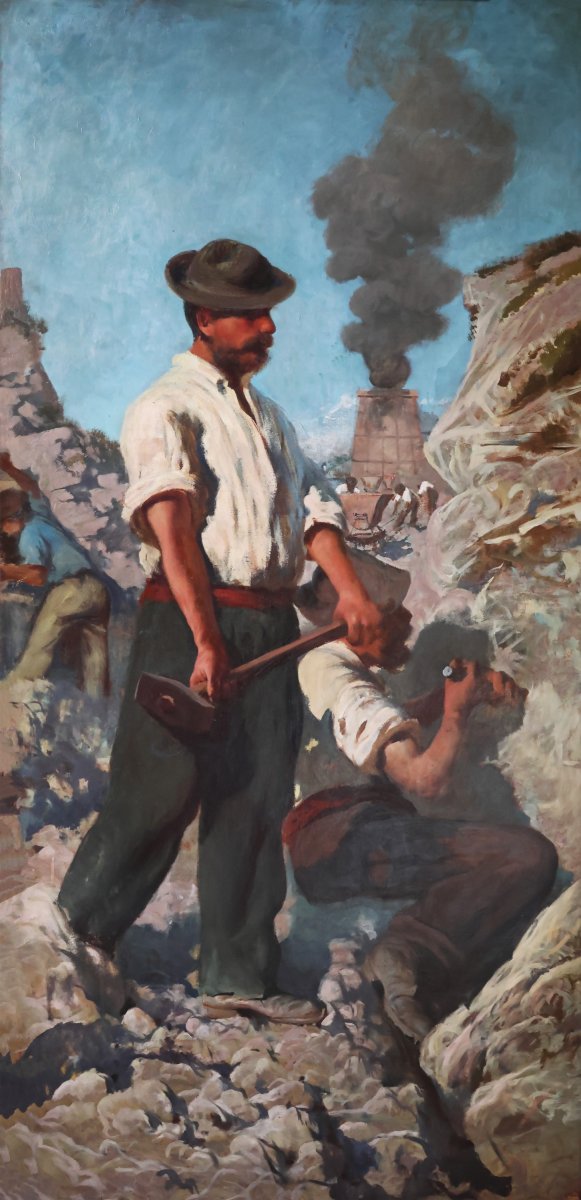Andrea Tavernier
Turin, 1858 – Grottaferrata, 1932
La cava di quarzo
1890-1900
Olio su tavola
in 70,87x34,65
This artwork, well known within the literature on the artist despite the lack of precise dating, stands as a figurative piece of great commitment, broad scope, and primary importance, particularly within the non-purely landscape-oriented dimension of the Turin painter’s oeuvre. After studying drawing and figure painting at the Accademia Albertina under Enrico Gamba, as well as painting with Andrea Gastaldi and assistant Pier Celestino Gilardini, the young Tavernier quickly emerged as one of the most promising talents of his generation. Early on, he displayed what critic Alessandro Stella described at the dawn of the 1890s as “vigor of expression, tones, and sentiment” and a capability for “exceedingly soft and facile execution.” The Quartz Quarry is a painting of solid construction in both design and brushwork, marked by robust social inspiration that lends the work a high idealistic tension, perfectly in tune with the vehement and vivid realism of a strikingly vibrant pictorial narrative. The two miners in the foreground, laboring in the quarry—one standing, the other seated on a rock—are rendered with extraordinary vigor and notable “plastic” power. Stylistic and thematic considerations suggest that this work belongs to Tavernier’s early maturity. During this period, as specialist Giuseppe Luigi Marino observes, the artist focused primarily on figures, already demonstrating his aptitude as a colorist with bold chromatic contrasts before moving, in the later stages of his career, to compositions in which the figure cedes its absolute dominance to enrich the landscape in diverse ways. This painting is a masterpiece of Tavernier’s social-realist style, as Angelo Dragone aptly noted in an article published in La Stampa on January 15, 1985. Dragone described The Quartz Quarry as “a canvas truly worthy of a museum.”
From the critical analysis; Armando Audoli, Turin
in 70,87x34,65
Pellissone Collection, Turin
Giovanni Matta Collection, Verolengo
Private Collection
Comanducci A. M., I Pittori italiani dell’Ottocento. Dizionario critico e documentario, Milan, Casa editrice artisti d’Italia S. A., 1934 XII, p. 724.
Marini Giuseppe Luigi, Andrea Tavernier. Regione Valle d’Aosta, Musumeci Editore, 1999.
Dragone Angelo, La Stampa. Paesaggi e figure dell’800, year 119, number 12, January 15 1985.
1982 Milan, Auction of 19th-century paintings, n.8, Manzoni-Finarte, 18-24 March: 95, The Quarz Quarry
Imperfections and restorations.
Since we are not professional conservators or restorers, we urge you to consult with a restorer or conservator of your choice who will be better able to provide a detailed, professional report. Prospective buyers should inspect each product to satisfy themselves as to condition and must understand that any statement made by Coradi Rare Finds is merely a subjective opinion.
Tavernier Andrea – Born in Turin on December 23, 1858, and died in Grottaferrata (Rome) on November 15, 1932, he was a landscape painter. He studied under Andrea Gastaldi at the Accademia Albertina, but he did not adopt his master's style, instead developing a distinct manner, particularly evident in his mature works. He first exhibited at the Turin Promotrice in 1884, presenting charming paintings such as Confidenze and Auree primaverili. He later exhibited Contrasti, a painting celebrated for its chromatic qualities; Il vegliardo; Lo stagno; and Finita la Messa—the latter three now part of the Civic Museum of Turin's collection. Ultime gocce, held in the Gallery of Modern Art in Rome, along with other works that followed, resulted from a productive period spent in the Roman countryside and along the Adriatic coast. His paintings also appeared at the Venice Biennales: Risveglio di un’anima (1901), Meriggio Alpino, Gli effimeri (a triptych), Nota azzurra, Verso l’ombra, Alla fontana, La Levanna, and Dopo la colpa (1903), Oracoli and Tramonto d’autunno (1905). Tavernier's canvases, marked by a healthy and genuine naturalism, can hold their own alongside the best works of Piedmontese landscape painters. Other notable works include: Lago Blu al Giomin (owned by Dr. Rossi of Turin), Il pittore Chessa nel mio studio, Autoritratto, La cava di quarzo (owned by Mr. Pellissone of Turin), Primavera e autunno (housed in the Revoltella Museum in Trieste), La sposa dell’espada.
Bibliography
Comanducci A. M., I Pittori italiani dell’Ottocento. Dizionario critico e documentario, Milan, Casa editrice artisti d’Italia S. A., 1934 XII, pp. 720–721.








